In This Topic
Each MyDraw drawing can have one or more pages. You can easily add, remove and rename pages using the Page Navigator. You can also use the page navigator to switch to a different page.
The sections below describe how to perform some common tasks on the current page.
Change page size
To change the size of the current page, right click somewhere in it and from the context menu that appears, select Page Properties. In the General Tab, there is a Size group section where you can select from the most often used prefined Page sizes or input width and height manually.
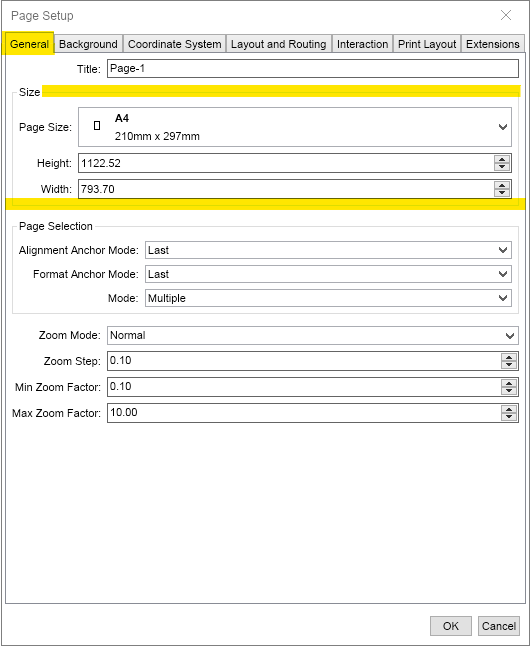
Page View Mode and Zooming
There are four types of page view modes available. Pages modes will automatically change their values based upon the printable page value set for the project (i.e., Letter, A4, A3, Legal).
Normal: This mode shows the drawing area at the default settings.
Fit to Page: This mode will show the area of a full printed page in the drawing area.
Fit to Width: Fit to Width will show the area of the width of a printed page in the drawing area, disregarding the height.
Fit to Height: Fit to Height will show the area of the height of a printed page in the drawing area, disregarding the width.
To change the Page View, go to the Page Setup - General Tab. There, you will find the Zoom mode drop-down with all four predefined modes.

Change page background and border
To change the background color and border of the page of your diagram, go to the Appearance tab. To edit the main color, select Background and choose the type of fill you’d like to use. You will find plenty of opportunities including Color Fill, Stock, Linear, Radial, or Advanced Gradient Fill, Hatch or Image Fill. Each of those fill types can be additionally modified to achieve the result you’re looking for.
To edit the border of your page, click the Border button and choose the type, color, and rounding of the border. Don’t forget to also specify border thickness. With MyDraw you can choose to have a border on all sides of your drawing area or on specific sides only.
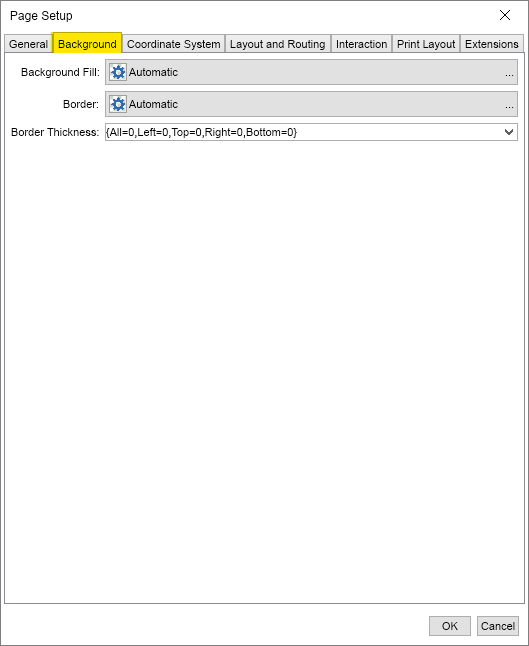
Change page drawing scale
MyDraw uses a special measurement unit for all display related measures, which is the DIP (device independent pixel that is 1/96 of an inch). By default the drawing scale is configured so 1 DIP equals 1 DIP (identity scale).
Some drawings, however, require to display either too small or too large scenes, which are impossible to visualize without a drawing scale. In order to visualize them in a comfortable for you manner you can use the drawing scale options.
The drawing scale is a user defined ratio between the logical unit and the display unit. For example, 1 meter = 1 mm is a commonly used Metric drawing scale. This means that 1 mm of your drawing represents 1 meter of the real world space.
You can change the page drawing scale from the Coordinate System tab of the Page Setup dialog, or you can simply right click one of the drawing view rulers and select Change Drawing Scale from the context menu. Then in the dialog that appears you can either enter the drawing scale manually from the measure up-down buttons or click the Load Drawing Scale button to select one of the predefined drawing scales. Changing the drawing scale will also change the measurement units of the ruler and the measurements of the currently selected diagram item, which are shown in the status bar.
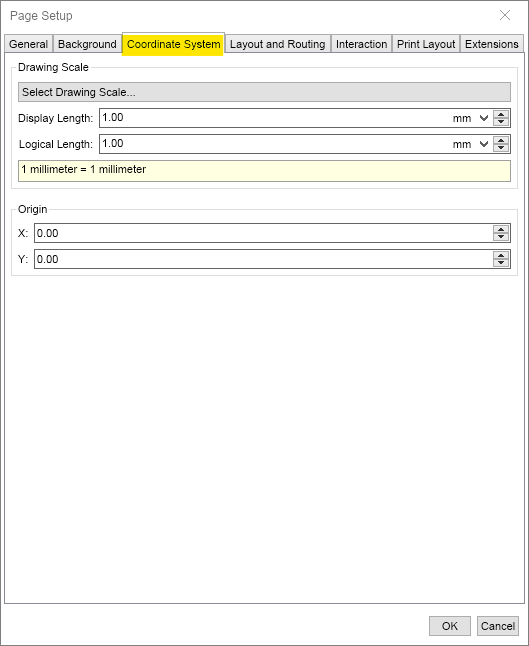
Padding
Page padding is the spacing applied to the page when you size it to its content by right-clicking somewhere in the page and selecting Size to Content.
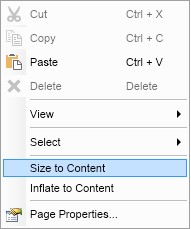
Layout and Routing
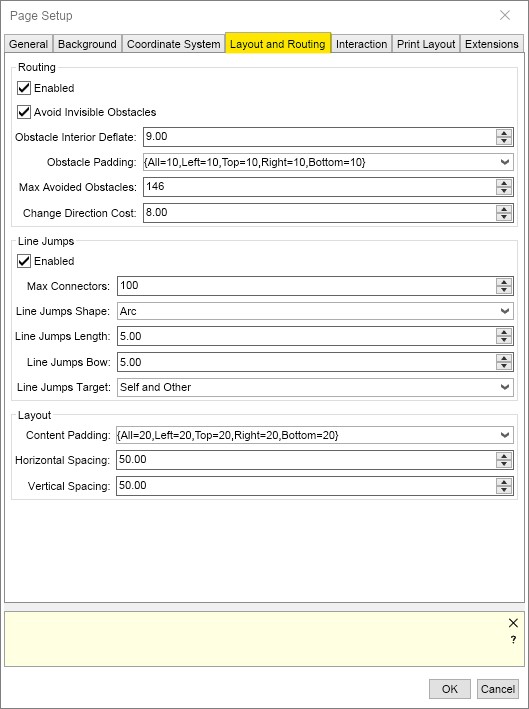
Routing:
Enable- specifies wheather the routing manager is enabled. Setting this property to false will globally disable automating rouitng.
Avoid Invisible Obstacles - Indicates whether invisible obstacles should be avoided by routes.
Obstacle Interior Deflate - Specifies the deflate of the non intersectable obstacles (2D shapes) interior.
Obstacle Padding - Specifies the padding applied to the obstacles (2D shape) bounds.
Max Avoided Obstacles - Controls the maximum count of obstacles (2D shapes) for which grid routing must be performed.
Change Direction Cost - Specifies the cost for making a turn (change direction). The settings is applicable for a grid routing only.
Line Jumps:
Enabled - Specifies whether the bridge manager is enabled. Setting this property to false will globally disable line jumps.
Max Connectors - Specifies the shape of the bridges that the connector displays.
Line Jumps Shape - Specifies the shape of the bridges that the connector displays.
Line Jumps Length - Specifies the length of the bridges that the connector displays.
Line Jumps Bow - Specifies the bow of the bridges that the connector displays.
Line Jumps Target - Specifies the target for the bridge generations.
Layout:
Current Padding - Specifies the padding, which are applied to the content when the surface is sized to it.
Horizontal Spacing - Specifies the horizontal spacing of the page layout.
Vertical Spacing - Specifies the vertical spacing of the page layout.
Interaction
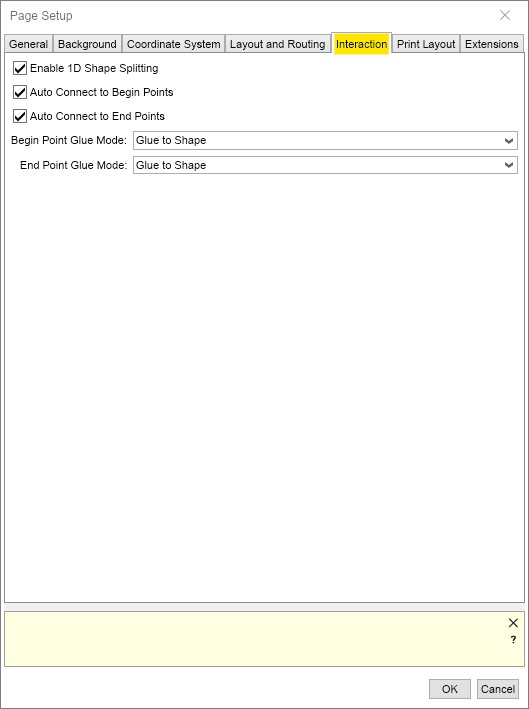
Enable 1D Shape Splitting - Specifies whether moved or dropped 2D shapes are allowed to split 1D shapes.
Auto Connect to Begin Points - Specifies whether moved or dropped 2D shapes are allowed to connect to the begin points of 1D shape.
Auto Connect to the End Points - Specifies whether moved or dropped 2D shapes are allowed to connect to the end points of 1D shapes.
Begin Point Glue Mode - Specifies the mode in which begin-points of splitted or extended 1D shapes are connected to 2D shapes.
End Point Glue Mode - Specifies the mode in which end-points of splitted or extended 1D shapes are connected to 2D shapes.
See Also





